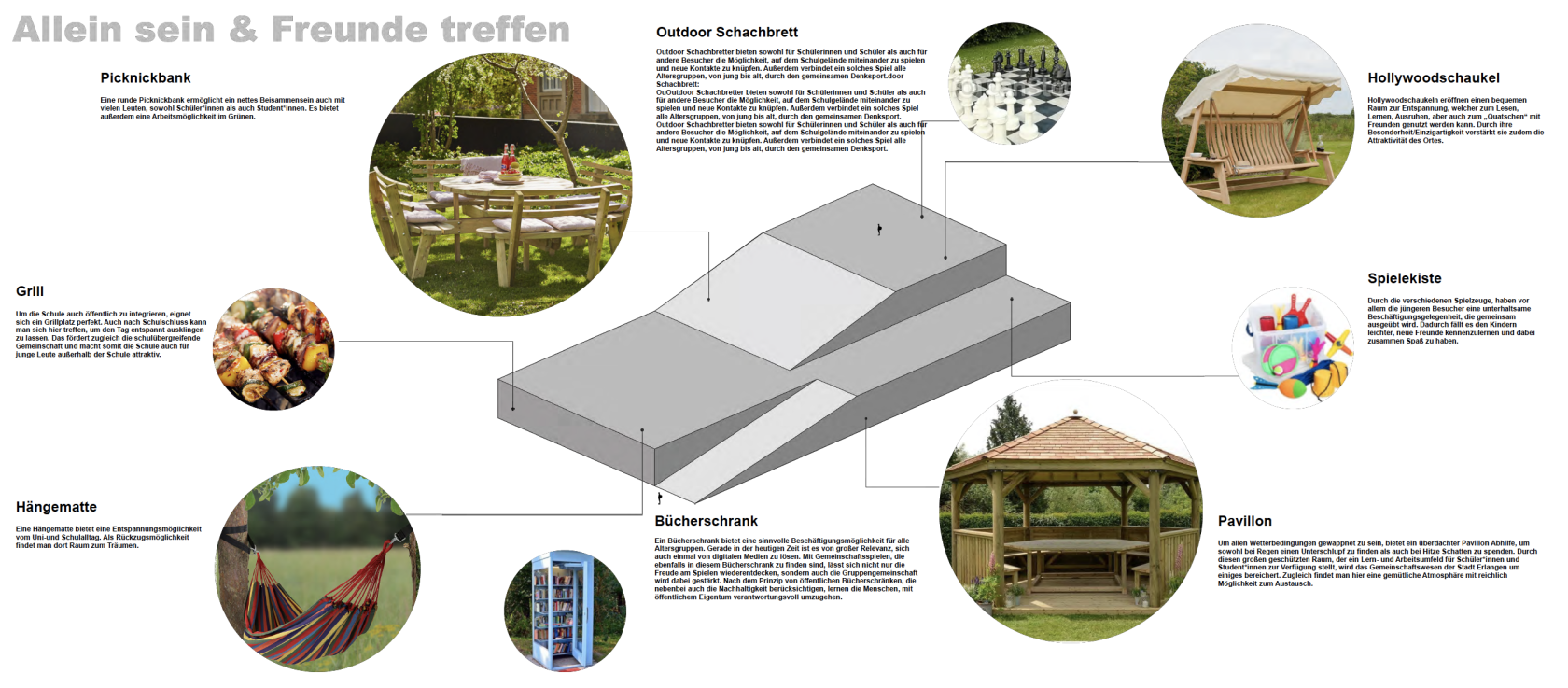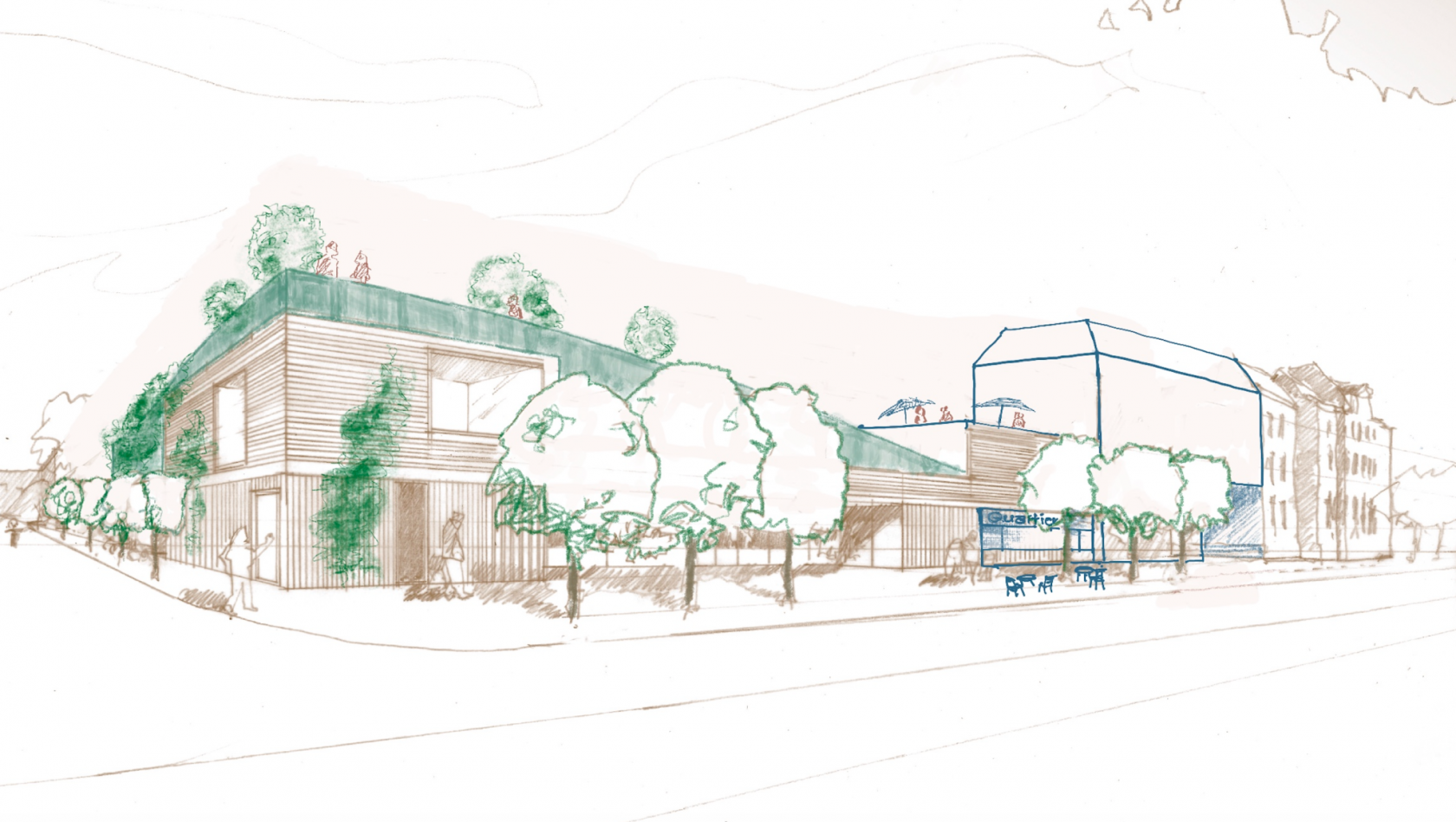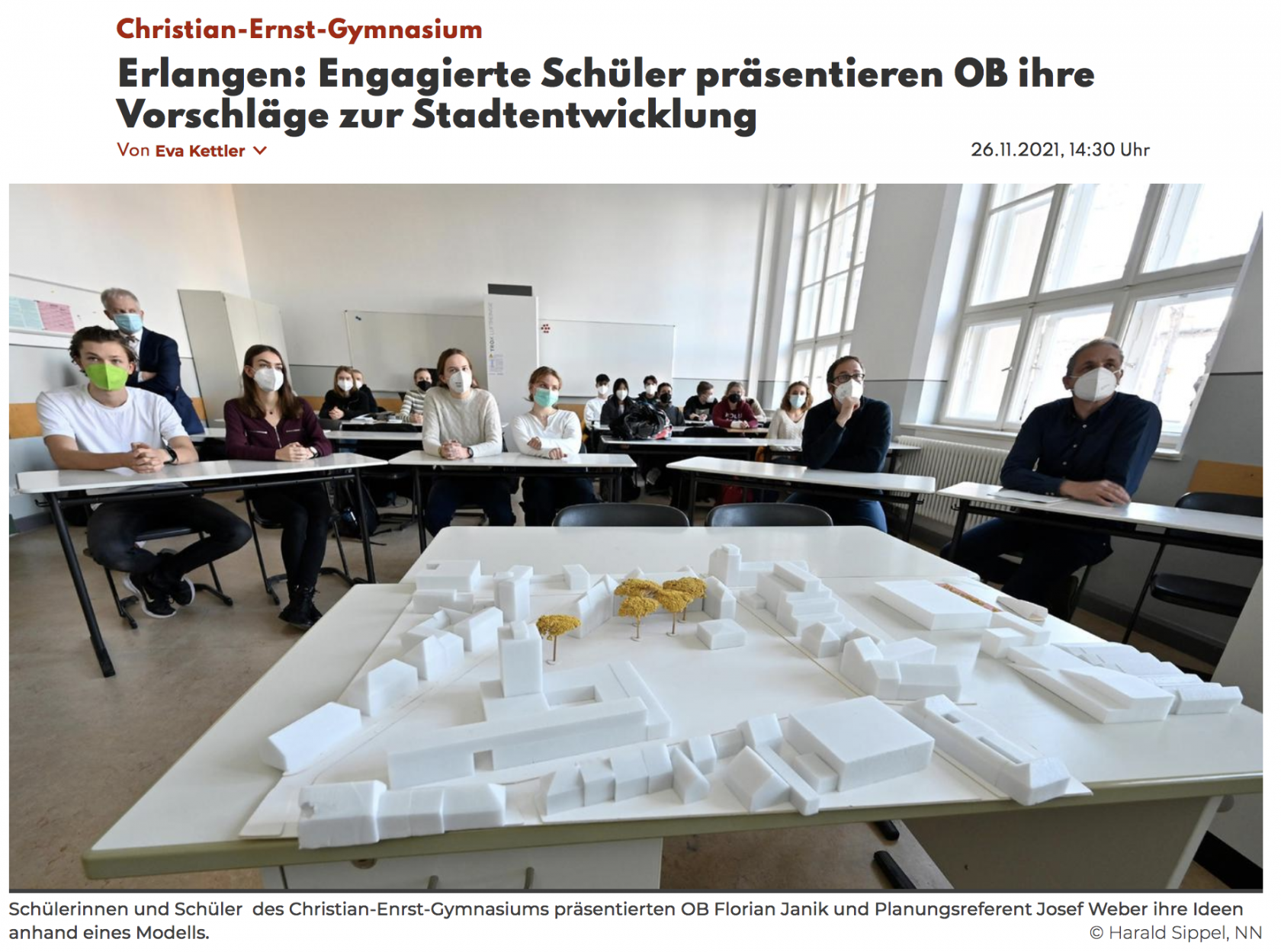14 Das Quartier offen planen
CEG & Makerspace+ | Ergebnisse aus der Zusammenarbeit mit dem ZAM (2022 – Part I)
Dokumentation der dritten Arbeitsphase des CEG (Juni – Juli) im ZAM-Projekt Post-Corona-Stadt-Erlangen (Projektphase I)
Bericht mit allen Bildern und Grafiken über das CEG-Blogprojekt "Stadtgeographie macht Schule | Schule macht Stadtgeographie": https://stadtgeographiemachtschule.wordpress.com/2022/09/24/ceg-makerspace-ergebnisse-aus-der-zusammenarbeit-mit-dem-zam/
In den Monaten Juni bis Juli wurde ein neues Arbeitsteam aus Schüler*innen der Kunstkurse von Diego Sindbert gewonnen, das im Schuljahr 2021/22 die begonnene Arbeit des Geographiekurses 2021/22 aufnahm und fortführte.
Hierfür wurden zunächst mit jedem der Kurse Treffen im ZAM anberaumt, bei denen die Schüler*innen die Vision, die hinter und im dem ZAM-Haus Erlangen steckt kennenlernten im Gespräch mit Jochen Hunger, einem der Initiatoren aus dem ZAM-Team.
Er stellte zum einen die Werkstätten vor und gab einen Überblick zum Projektrahmen der Post-Corona-Stadt-Initiative, innerhalb dessen auch das Projekt des Christian-Ernst-Gymnasiums angesiedelt ist (vgl. Jochen Hunger, Bericht vom 15. Bundeskongress Nationale Stadtentwicklungspolitik, 14. bis 16. September in Berlin).
Die dritte Arbeitsphase wurde anschließend zwischen Diego Sindbert, Lehrer für Kunsterziehung am CEG, und Jochen Hunger geplant sowie in drei Praxisfelder aufgeteilt, von denen zwei als kollaborative Projektarbeit gestaltet wurden:
- Teilnahme an ZAM-Foren, u. a. Ausstellung „Know-how teilen macht Städte stark“
- Visionen & Konzepte: Arbeit von Expert*innen des ZAM (u. a. von Bernd Hoge Architectes mit einer Kleingruppe von Schüler*innen des Christian-Ernst-Gymnasiums in den Werkstätten des ZAM (Zeichnung, Schnitt, 3D-Modell – mit Lineal und Stift oder mit TinkerCad; Arbeiten mit Repräsentationen im Modell: Modellbau)
- Umsetzungen und Konkretisierungen von Visionen & Konzepten: Arbeit der Schüler*innen im Kunstunterricht des Christian-Ernst-Gymnasiums unter Einbezug von weiteren Fächern (Politik/Sozailkunde & Deutsch)
Zu Fotos aus der Arbeit im ZAM über: https://stadtgeographiemachtschule.wordpress.com/2022/09/24/ceg-makerspace-ergebnisse-aus-der-zusammenarbeit-mit-dem-zam/
Ergebnisse der dritten Arbeitsphase waren somit Ausgestaltungen der Vorarbeit der Geographie-Gruppe Q11/12 aus dem laufenden Schuljahr. Diese hatten die Vision vorgelegt, die Oberfläche des von der Stadt Erlangen geplanten Turhallenbaus als für die Schüler*innen und die Bewohner*innen des Quartiers begehbaren Erholungsraumes zu gestalten; die Schüler*innen der 10. Klasse aus den Kunstkursen von Diego Sindbert arbeiteten diese Vision nun unter vier Perspektiven aus:
Zu den weiteren Plakaten und Arbeitsergebnissen: https://stadtgeographiemachtschule.wordpress.com/2022/09/24/ceg-makerspace-ergebnisse-aus-der-zusammenarbeit-mit-dem-zam/
Die Vision: Gestaltung
https://stadtgeographiemachtschule.wordpress.com/2021/11/17/die-zukunft-beginnt-hier-makerspace/
Projektziele
1. Planung eines Anbaus an das CEG mit Übergang zu einer neuen Turnhalle, bei der eine grüne Architektur prägend ist; der Anbau soll folgende Räumlichkeiten enthalten: Bibliothek, Workspaces, Mensa mit Verkauf zur Straße und Cafébetrieb, Klassenräume, Räume für Mittagsbetreuung.
2. Planung des Quartiers als offener Raum, der von anderen Stakeholdern als Angehörigen der Schule genutzt werden kann.
Grober Zeitplan [bitte jeweils geplantes Datum angeben; Anfang - Mitte - Ende Monat, z.B. A.02.22 für Anfang Februar 2022]
|
Konzept steht |
Team an Bord | Umsetzung Start | Erste aussagekräftige (Zwischen-) Ergebnisse | Umsetzung abgeschlossen (Ziel) | Zeitraum für Dokumentation, Abrechnung |
|
24.11.2021 |
24.11.2021 | A.01.22 | A.03.22 | E.05.22 | E.06.22 |
|
Anmerkungen |
weiterer Verlauf abhängig von Absprache mit Makerspace |
Gewünschte Ressourcen [Zuschüsse und Materialien / Raum / Werkzeuge / Know-how]
| Material | Raum | Werkzeuge | Know-how |
| Konzeptionsmaterial 350,- | Makerspace | ||
| Modellbaumaterial 550,- | Makerspace | ||
| Zuschüsse | |||
|
8 x ca. 10 Std./Woche studentische Hilfskraft (Architektur) =2 Monate a 450.-€ |
|||
| Zeit- und Kostenaufwand bisheriger Arbeiten (Planung, Qualifizierung, Workshopdurchführung, Modellbau, Dokumentation vgl. https://stadtgeographiemachtschule.wordpress.com/) |
10 x 120min Workshoparbeit im Projekt 24 x 60 min Organisationsaufwand für Lehrkraft inkl. Projektdokumentation auf dem eingerichteten Blog |
10 x 10 Stunden/Woche studentische Hilfskraft für Planung, Druchführung, Modellbau, Zeichnungen, Plakate |
Student (Architektur) Lehrkraft (Stadtgeographie) |
Die Projektbeschreibung [letzter Stand]
Ausgangssituation vor Projektstart: https://stadtgeographiemachtschule.wordpress.com/
Bilder, Zeichnungen [zur Verdeutlichung der Projektidee]
vgl. https://stadtgeographiemachtschule.wordpress.com/
---------------------------------------------------------------------------------------------------------------------------------------
LOGBUCH [Hier beginnt die Dokumentation wichtiger Etappen des Projektes in Text, Bild, Video...]
25.10.2022
StandStefan 17.03.2022Applis
School as a closed or open architectural space?
Pupils from Erlangen intervene in the city's plans to redesign the school premises
In the southern German city of Erlangen, planning by the municipal administration in 2021 was initially proceeding as usual: an old sports facility used by several schools and sports clubs had to be demolished due to structural deficiencies. Therefore, they planned a new sports hall building to be larger with a view to the future. At the same time, the new building was to accommodate the municipal sports administration and relieve the parking situation for commuter traffic with an underground garage. Directly next to the dilapidated sports hall is an ample open space that until then had been used as the sports grounds of the adjacent Christian Ernst High School and as an extended break yard for free play between classes. The idea of the city administration was the following: One would place the new building on top of the free space of the school and push the permissible building height to the limit to make maximum use of the structure.
The result, however, was anything but satisfactory from the point of view of the school headmaster and the parents' committees to whom the preliminary plans were presented. Instead, they were shocked that the open spaces for the pupils, which are essential for their recreation during the breaks, would be severely restricted. Furthermore, a building was to be erected that shocked everyone concerned with its sheer mass. Hardly anyone could imagine how it would integrate into the whole neighborhood next to the listed school building.
School students plan the school space as an open urban space
Therefore, they also started to inform the school students and address them as experts for the space in which they spend so much of their day. The whole thing started in a geography class that dealt with questions about shaping urban space with citizen participation. Here, they formulated the first goals of the project:
- The school should lose as little free sports and recreation space as possible.
- The newly developed spaces and buildings should also be accessible to other citizens, e.g. students of the neighboring university and residents.
- The whole neighborhood was to be included in the planning so that existing isolations of users of the subspaces could be overcome.
In the first step, school students, with the support of an architecture student, built an environment model of the so-called neighborhood. The first step was to measure the area on which the model of the surroundings was to be built so that the streets and building areas could be scaled in the model. Some of the pupils took data from the so-called Bayernatlas, the geo-portal of Bavaria, and transferred it to a cardboard base. After that, they cut the cardboard base to create building areas and pavements. Furthermore, all building dimensions had to be read out. These had to be converted to scale before the existing building stock was modelled out of Styrodur panels. For all this work, several process phases were necessary.
Consequently, the students had to coordinate the data generation on the computer and the different model-building phases. The "Design" working group faced the challenge of coordinating the essential functions of sport, parking, education and entertainment, which were at least fundamentally fixed by the municipality. To do this, the students had to develop a creative idea of the future on the one hand, which they would then work on further. On the other hand, they had to deal with concrete legal and construction requirements for certain buildings (e.g. sports hall, underground car park).
Finally, the concept was to assign new uses to the school space. This gave rise to the idea of an "urban hill" that could also be used by people other than members of the school. The sports hall, equipped with a green roof, could serve as a recreational area. This way, the lost green space could be replaced by an urban enhancement. It would also be conceivable to have a kind of gradation that functions as a row of seating areas and, thus, as a grandstand from which the adjacent sports area is visible. Above all, it was important that the new sports hall does not sit as a foreign structure in the new neighborhood but can be used as part of the urban space, e.g. by residents and university students who are out and about.
To this end, the future plans of the University of Erlangen-Nuremberg should also be included. Since the Siemens company left one of its founding buildings in Germany, a listed building, to the university, a new so-called "axis of science" is being created in the city. Therefore, school management, students, parents and teachers argued that the street currently used by cars, which connects the new university buildings with old university buildings, should be traffic-calmed. This would also allow the new open school grounds planned by the students to contribute to a new urban quality. The walkable and green architecture of the student-planned sports hall could become a new park in the middle of the city center, where university students could also spend time and engage in conversation with the school's students. In this way, it would be possible to expand the school's cafeteria service and create a new café that would bring people from the neighborhood together.
Cooperation with other actors in urban development
When the students and their teachers realized that follow-up planning questions arose that they could not answer with their expertise alone, they looked for competent actors from the civil society sector who could support the project. Through a successful application to the ZAM (Centre for Exchange and Making), which the German government financially supports within the funding initiative "KNOW HOW TEARING MAKES CITIES STRONG", the school found a competent project partner.
ZAM is pursuing the goal of establishing a communicative and productive meeting place in the old town of Erlangen, referred to as a "Makerspace". Here, an easily accessible meeting space for new forms of mutual learning, urban production, studios, co-working spaces, and pop-up stores for DIY and services is being developed. Through the "Makerspace", residents' digital skills can also be grown and expanded, e.g. by promoting hackathons and workshops with new technology (e.g. 3D printers, etc.).
The overall goal of ZAM is the permanent rededication and expansion of a building complex vacated by the Corona pandemic into a center of exchange and cooperation. So-called "FabLabs" are opened to create a central place for innovation and encounters. These are open workshops or groups of different workshops where people can experiment with making prototypes.
In this work phase, school students and teachers from art courses now entered into a collaborative project work with the experts from ZAM, which included the following topics:
- Participation in ZAM forums, including the exhibition "Sharing know-how, makes cities strong".
- Development of visions and concepts in the ZAM workshops for possible uses of the school premises, including new architecture.
- Implementation and concretization of visions and concepts in art lessons at the Christian-Ernst-High School, including other subjects such as politics.
The outcome of the undertakings is still open. Since the municipal administration is free to dispose of urban space, the students of the Christian Ernst High School, the school management, teachers and parents have no more than the possibility to appeal for their visions to be heard. However, several press reports have written about the school students’ alternative architectures that would open up the school space to shared use by all citizens. The city mayor has already been to the school for several meetings and is willing to talk. The project is an excellent example of how young people, supported by the school and civil society initiatives, can participate in processes about the formation of urban spaces.
Links:
Concerning the funding programme of the Federal Government of Germany: https://www.nationale-stadtentwicklungspolitik.de/NSPWeb/SharedDocs/Projekte/Pilotprojekt/Post-Corona-Stadt/erlangen_know_how_teilen_macht_staedte_stark.html
ZAM / Makerspace Erlangen: https://www.zam.haus/vision/?doing_wp_cron=1666456571.2205090522766113281250
Geoportal of Bavaria (Southern Germany): https://geoportal.bayern.de/bayernatlas/?topic=ba&lang=de&bgLayer=atkis&catalogNodes=11
The project in the press:
Bericht der Erlanger Nachrichten vom 26.11.2021:
Mail Applis -> Hunger 24.11.21
Kurzbericht über Besuch von OB Yannik und Herrn Weber, dem Referenten für Planen Bauen; Anwesenheit der Presse (Erlanger Nachrichten, Bericht folgt in den nächsten Tagen):
- Kurzvorstellung der bisherigen Ergebnisse der Projektarbeit mit drei Teilbereichen: 1 Freilichtbühne mit Tiefgarage und Fahrradstellplatz, 2 Flächenbegrenzte begehbare Turnhalle zur Schaffung eines urbanen Grünraumes, 3 Anbau an südliche Brandand des CEG mit Verbindung zu Turnhalle unter Einbezug zusätzlicher Funktionen (vgl. https://stadtgeographiemachtschule.wordpress.com/2021/11/17/die-zukunft-beginnt-hier-makerspace/)
- Vorstellung der Projektziele in Makerspace+
- positive und konstruktive Rückmeldung beider Gäste: Aussicht auf Teilnahme als Ideengeber im Architekturwettbewerb - über Modi der Beteiligung wird beraten und informiert; Herr Weber stellt Organisation eines Planspieles in Aussicht, bei dem die Schülerinnen und Schüler an einem Entscheidungprozess zur Bauprojekten in einem Stadtraum teilnehmen können
--------------------------------------------
20.11.21 Tel mit Herrn Applis
Im Projekt überlagern sich viele Interessen; das bindet Kräfte und macht Vorwärtskommen anstrengend. Was wäre, wenn man die Interessenstränge auseinanderzieht, und sie einzeln betrachtet, um daraus ein Vorgehen zu entwickeln?
1. Interesse der Schule, ein gutes Umfeld zu haben
2. Interesse der Schülerinnen und Schüler, an diesem Umfeld mitzugestalten und Einblicke in Architektur und Politik zu haben (Selbstwirksamkeit; Berufsperspektiven)
3. Interesse des Post Corona Projektes, Beispiele für gelungene Know-how Transfers zu finden
[Jochen Hunger]
------------------------------------------------
Mail Hr Applis 17.11.21
Herausforderungen für weitere Projektdurchführung
- Zeitressourcen der Lehrkraft, starke Bindung in anderen Aufgaben
- Zeitressourcen der Schülerinnen und Schüler, die im Projekt arbeiten möchten wegen Vorbereitung des Abiturs; sechs bis acht Schülerinnen und Schüler sollten ab gut motivierbar sein, an sechs acht zeitlich fest umgrenzten Workshops von 90 bis 135 Minuten teilzunehmen von Januar bis Mai, auch wenn nicht immer alle teilnehmen können
- Bisherige Lösung: zeitaufwändige Arbeiten wie Fertigstellung von Modellen, Zeichnen usw., die teilweise besondere technischen Fähigkeiten fordern, wurden durch Architekturstudenten stark unterstützt und teilweise ganz geleistet im Rahmen eines Studentenwerkvertrages (9,60€/Stunde)
- Von Seiten des CEG besteht das Interesse vor dem Hintergrund des starken öffentlich-politischen Interesses, Interesses der Schulen, die bisherige Qualität der Arbeit zu sichern und auszuweiten, deshalb sehen wir eine vergleichbare Lösung als sinnvoll an: Kreativarbeit der Schüler*innen und Schüler mit teilweisen Ausarbeitungen und Impulsen für weitere Ausarbeitung durhc Architekturstudenten
Die Materialkosten dürften stark begrenzt sein, nehmen wir mal an, am Ende steht das Folgende:
- Erweiterung des Styrodur-Grundmodells in einem Ergebnis, das alle Varianten enthält, die den zentralen Zielstellungen entsprechen (v. a. Durchgängigkeit für die Öffentlichkeit und Nutzung verschiedener Stakeholder
- Architekturzeichnungen zur Umsetzung des Anbaus an das CEG entsprechend der skizzierten Bestandteile des neuen Gebäudes
- Architekturmodell zumindest eines der neu geplanten Gebäude



